        |
Cypress Hills CemeteryPrior to 1847, it was common for most burials to take place in church graveyards or on farmlands. A series of cholera epidemics led to restrictions on burials in Manhattan. In 1847, a bill was passed that permitted private enterprises to purchase land and sell burial plots for profit. The available land was primarily in Brooklyn and Queens, and there was an active business in digging up remains and shipping them to rural cemeteries. Cypress Hills became one of the earliest private non-sectarian cemeteries in 1848. The first white settler to own the land was Thomas Betts, but it was owned by Abraham Van Siclen at the time it was sold to Cypress Cemetery. In order to get around size limitations, cemeteries would span across borough borders. In the 1860s, demand for burial space for Civil War mortalities led to the sale of part of Cypress Hills for a National Cemetery. |
||
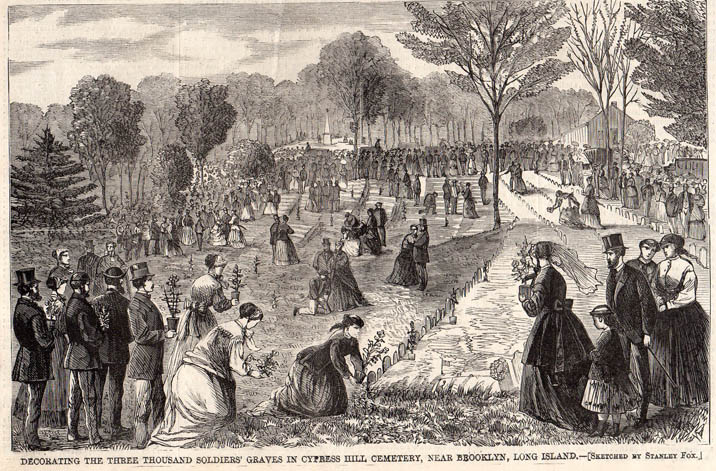 |
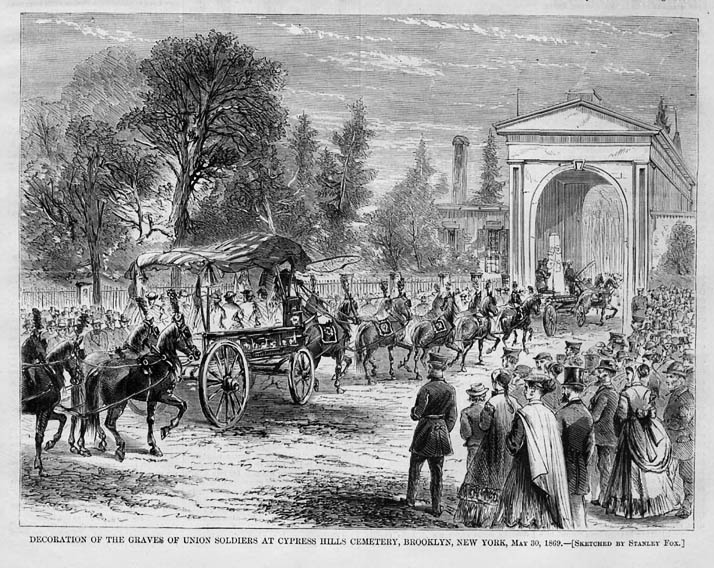 |
Harper's weekly provided some early views of the cemetery via these etchings. "Decoration Day" (1868), when the war dead were honored, would eventually become Memorial Day (thanks to the efforts of General John A. Logan, for whom Logan Street is named.) On the right, the original south entrance of the cemetery, facing Jamaica Avenue, in 1869. |
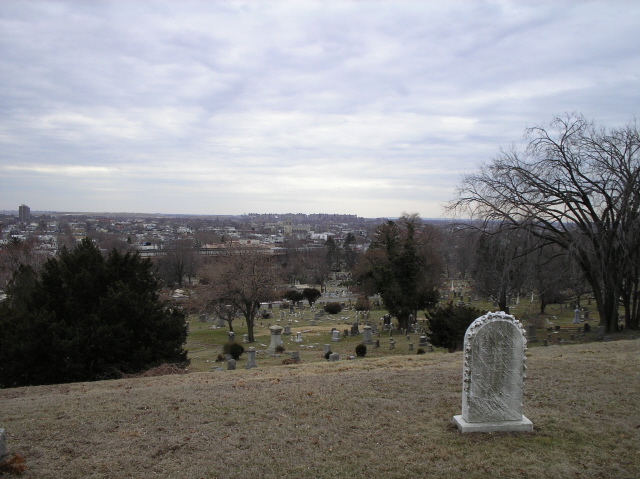 |
Views from Cypress Hills Cemetery Did you know? The views from the top of the cemetery go a long way, and in 1855 the cemetery constructed a 140-foot-tall observation tower which took them even further. The U.S. Government even used it for coastal surveys, because it could be seen from the ocean with the aide of reflectors. Built from wood, it eventually rotted and had to be torn down in 1894. It was located in the Mount Victory area but we do not have a picture. An odd note appeared in an 1866 Brooklyn Eagle article; "The wooden observatory in Cypress Hills is often mistaken for the marble monument which Long Island was to rear to the memory of General Woodhull. In the cars the writer heard asked the question "is that the Woodhull monument?"and the answer came, "yes, don't you see the whole of it is in wood? |
|
 |
The Cemetery issued a publication in the 1850s that gave the history including the Rural Cemetery Act that made the cemetery possible. It also listed all the owners. It was quite common for church groups to purchase entire sections for use by their congregation. The publication was also full of ads, not surprisingly, for undertakers, florists, and stoneworkers. I found an ad from Joseph Banzer, who founded an amusement area on the land bordered by the cemetery and the reservoir. His descendants confirmed to me he was trained in Granite work in Germany so it all lines up. Another interesting tidbit; Machpela Cemetery, listed in the ad, is where Houdini is buried. | |
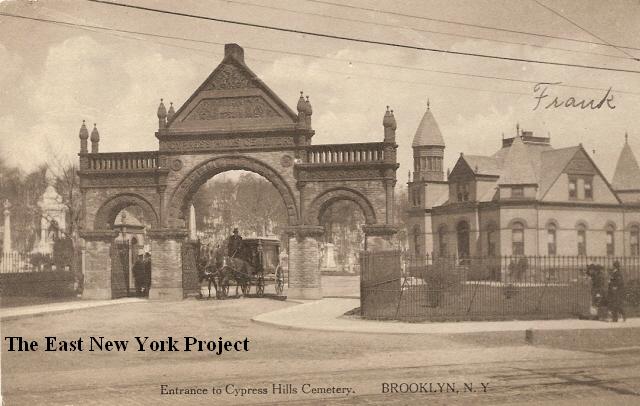 |
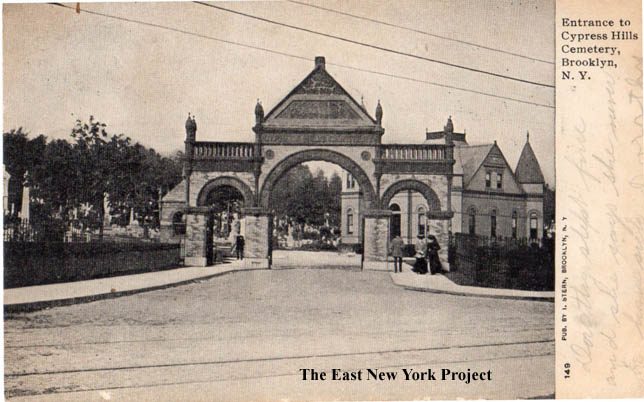 |
Entrance to Cypress Hills Cemetery Maker: Wm Fick Dated: unknown Status: need Entrance to Cypress Hills Cemetery Maker: I. Stern Dated: 1906 Status:Own(RG) The wooden entrance was replaced by this arch in 1893 (the date can be seen on the arch). The office was planned at the same time but not built until 1896. Although it appears to be brick, it is mostly woodframe painted to look like brick. The tower held a bell that used to sit right at the entrance. In Duer's book he notes the building was removed in the 1960s. |
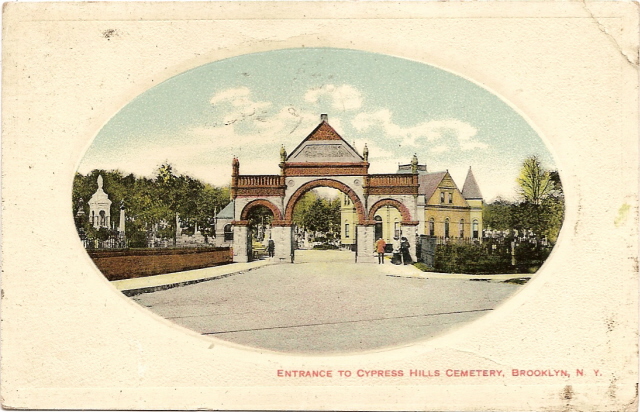 |
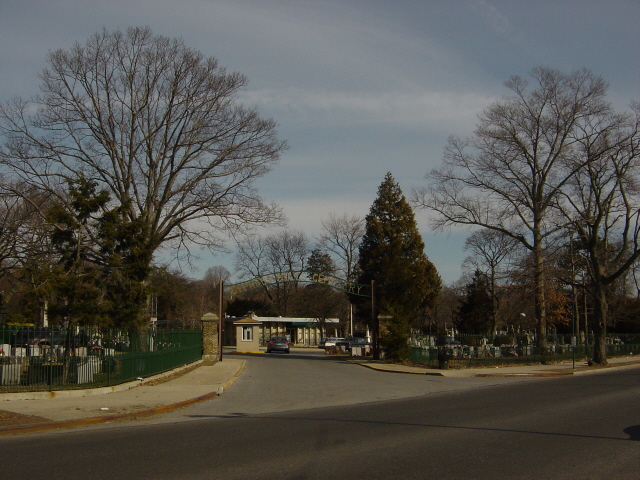 |
Entrance to Cypress Hills Cemetery Maker: Unk., German Dated: 1911 Status: Own(RG) This one appeared recently by an unknown maker, postally cancelled in 1911. A rare handcolored shot of the entrance. Printed in Germany. The cemetery was set up as incorporated Trust, so there was no mechanism to raise funds like issuing stock or debt- so the Trustees approached the owners of the plots for subscriptions of $2 a plot to raise the funds to build the arch and the office. The 2005 shot shows this ornate entrance is long gone - we do not know when the arch was removed. |
| New Entrance to Cypress Hills Cemetery, 2011 Tom Hammond tipped us off in 2011 that an entrance that pays homage to the original was completed. |
||
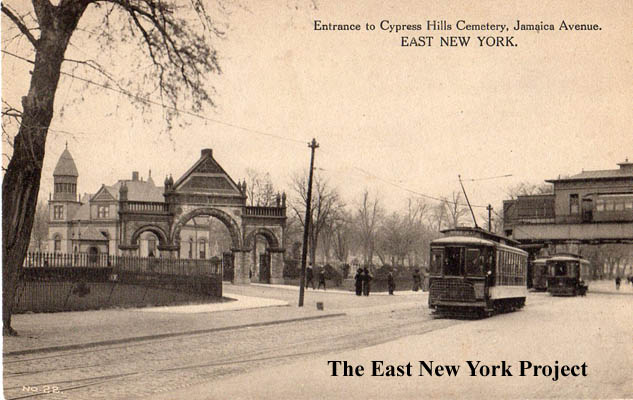 |
Entrance to Cypress Hills Cemetery, Jamaica Avenue Maker: P. Miller Dated: unknown Status: Own (RG) This terrific P.Miller card encapsules a lot of history. The cemeteries on Jamaica Avenue were a booming business for the transportation companies. We see an electric trolley in this early image; Jamaica Avenue was the second electrified trolley line in the country. In the background is the Cypress Hills train station. At this time it was the final stop on the line. It is no coincidence that the Brooklyn Elevated Co. extended the line from Van Siclen Avenue to here in 1893; they wanted the lucrative cemetery-visitor traffic, and there was a rush to have it ready by Memorial Day. Visit the Crescent Avenue page for more pictures and history on the station. Finally, some versions of this card are entitled "Jamaica Avenue Entrance to Cypress Hills Cemetery". The cemetery's west entrance was considered the funeral entrance, and at one time it had a bell tower which was used to alert cemetery workers of an approaching funeral procession. |
|
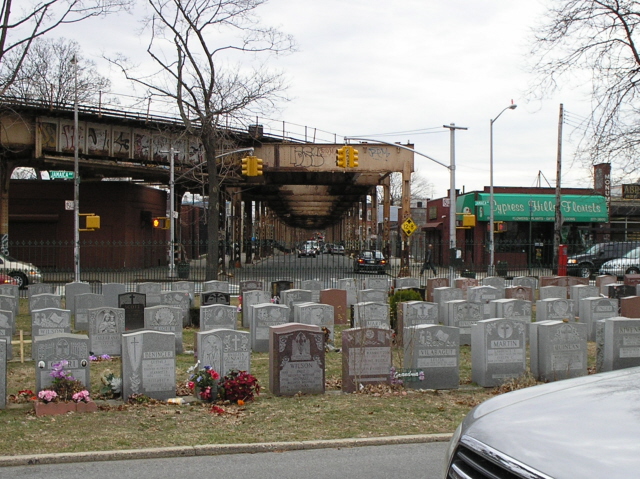 |
Views from Cypress Cemetery Neil Sullivan supplied the 2005 view looking south down Crescent Ave. from the cemetery. Note the elevated supports which held the original tracks when the line stopped at Cypress Hills are still there. |
|
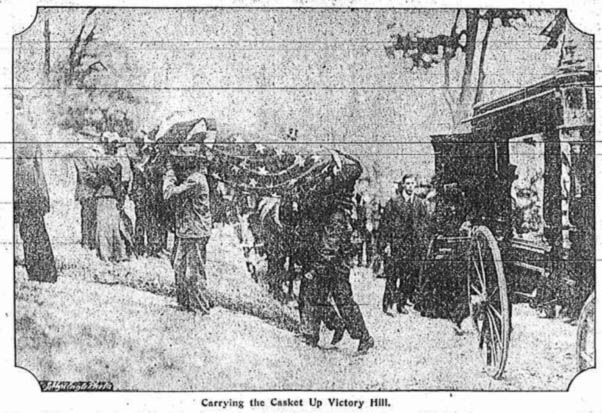 |
 |
Hiram Cronk Hiram Cronk was the oldest surviving veteran of the War of 1812. When he passed in 1905, it was a major event. 10,000 observers paid their respects as he lay in state in City Hall, and these pictures appeared in the May 19, 1905 edition of the Brooklyn Daily Eagle as he was laid to rest in Cypress Hills. |
 |
Mike Greaney used to work summers at the cemetery, and awhile back he sent me this story. To my amazement (and his), I came across this picture in a reprint of the old King's Photographs of Brooklyn circa 1906. |
|
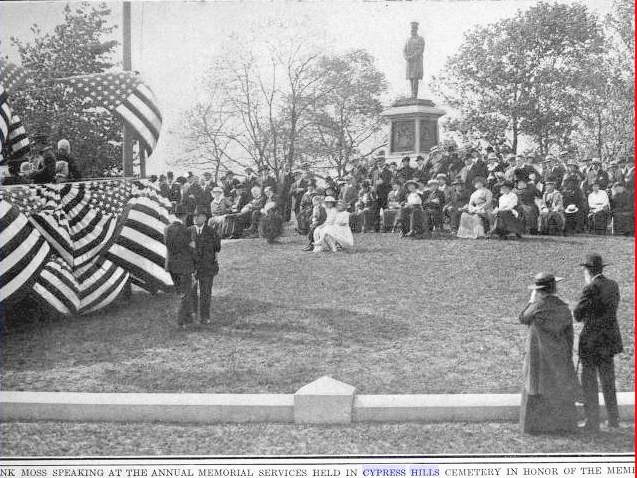 |
This image appeared in the June 10, 1917 edition of the New York Times. It was an annual ceremony dedicated to the memory of New York Police officers who had lost their lives in the line of duty. The statue on that monument is gone. Amazingly, the 2,000 pound statue was STOLEN in 1966. Thanks to Judy Close who tipped me off there is a Facebook page "NYPD Police Arlington Cypress Hills Gardens" with more history and background. | |
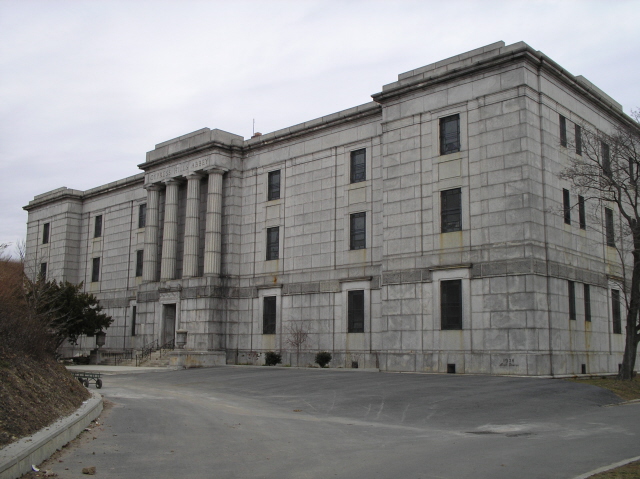 |
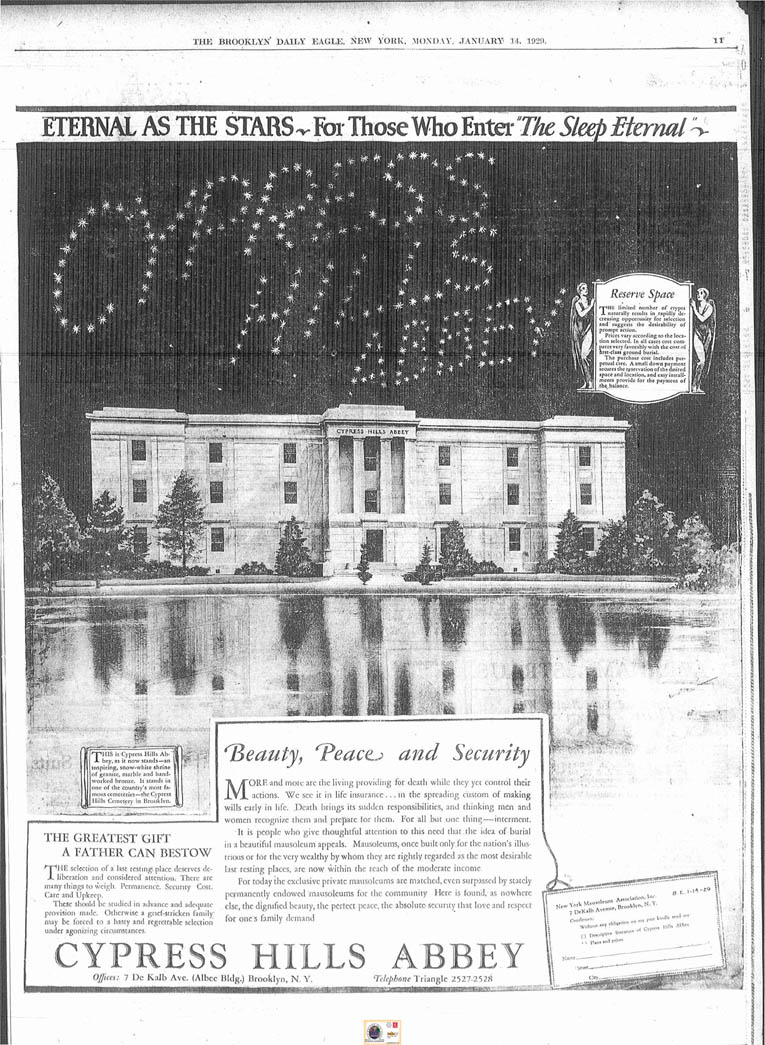 |
Cypress Hills Abbey The large Abbey was built in 1929, and Mae West is buried in one of the crypts inside. Judy Close has provided us with an update; the cemetery no longer provides access to Mae West's crypt, in deference to privacy for the family. Judy provides some background on an earlier trip in the story below. Check out the full-page Eagle ad when the Abbey opened. Memorial Abbey followed in 1931; Cypress Hills remains the only cemetery with 2 Abbeys.  |
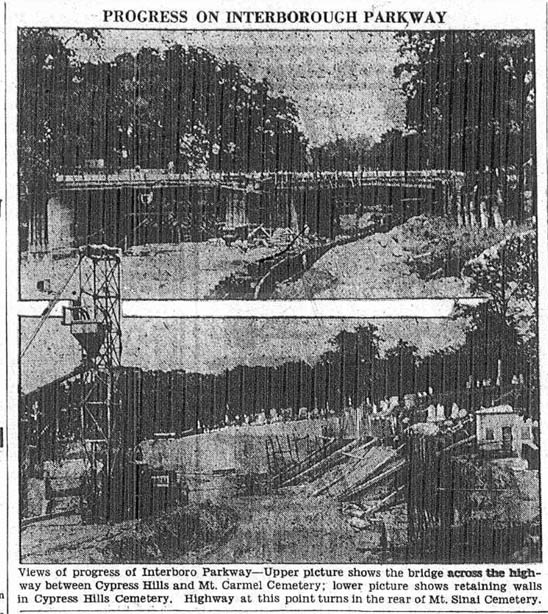 |
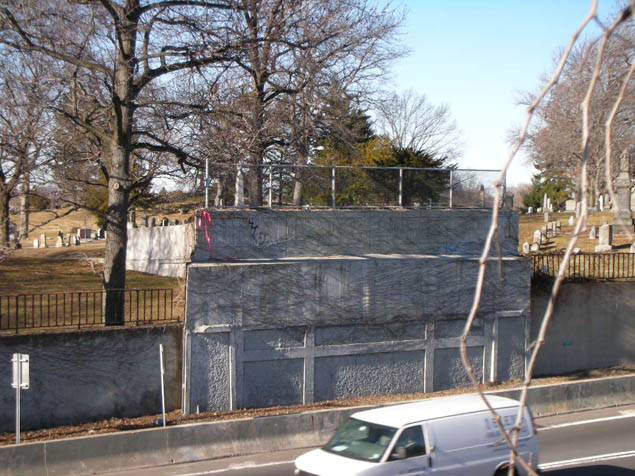 |
Interboro Parkway The history of the Parkway is tied to Cypress Hills. The roadway had been envisioned since the 1890s, but any plan required the path to cut through Cypress Hills. Most East New Yorkers know that the treacherous curves of the Parkway were due to the efforts of minimizing the number of re-interments required to build the road. A lesser known fact is that the city built the bridges which connect the north and south sides of the cemetery, seen in the 1931 Eagle images. When those bridges deteriorated, neither the city nor the cemetery were prepared (or willing) to finance repairs. As a result, the bridges have been removed by the city. |
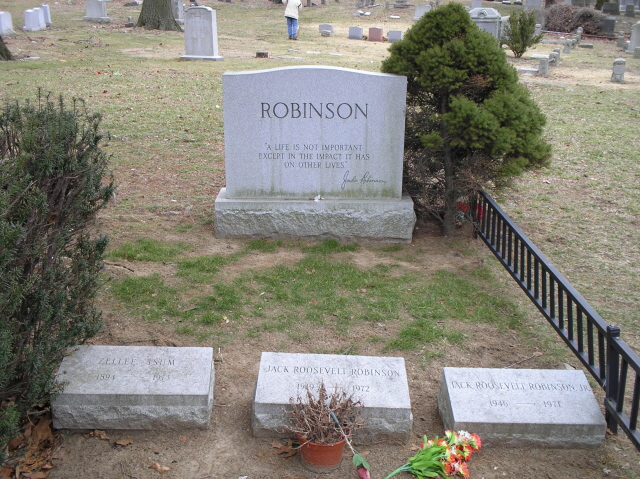 |
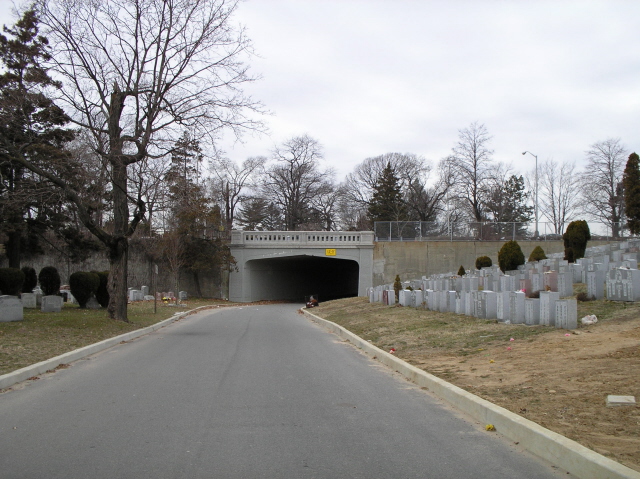 |
Jackie Robinson Jackie is interred on the Queens side of the cemetery. The parkway was renamed the Jackie Robinson Parkway in 1997 to celebrate the 50th anniversary of breaking the color line in baseball. On the right, the roadway passing underneath the parkway is the remaining north-south connection. Thanks to Neil Sullivan for the images. |
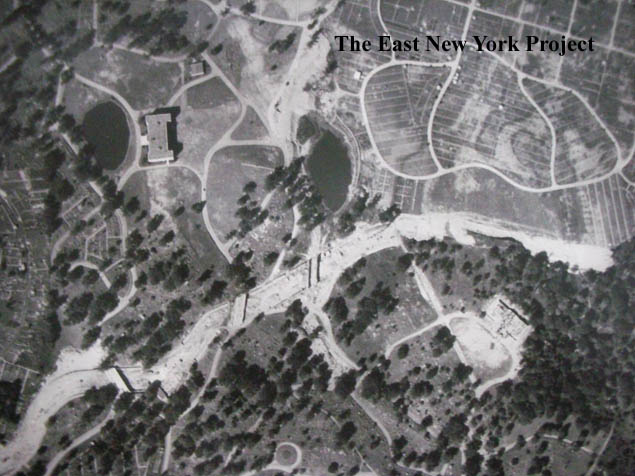 |
Aerial, 1932 This aerial shows the Interboro under construction and the two completed abbeys. Note the lakes visible on the property. Duer notes in his book that at one time there were 13 lakes or ponds on the property. Over time they were all filled in to create more burial grounds. Re-landscaping to create more burial space is common, but not always without controversy. In 1985 the cemetery allowed a contractor to dump construction debris to fill larger areas - (Presumably just concrete and rocks from demolished roads) and then placed a 10-foot cover of soil to use the same land for burials. Not surprisingly, this created a huge backlash when other construction debris was discovered. |
|
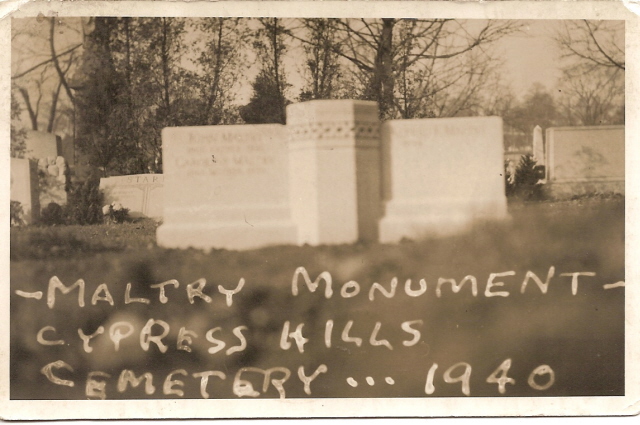 |
This appears to be a photo mailed out by Alfred Maltry in 1940 of a monument in Cypress Hills. | |
 |
Neil Sullivan contributed a map. Note how the cemetery straddles the boroughs. Corporations were limited to buying 250 acres so one way around it was to straddle the two boroughs for a larger allotment. | |
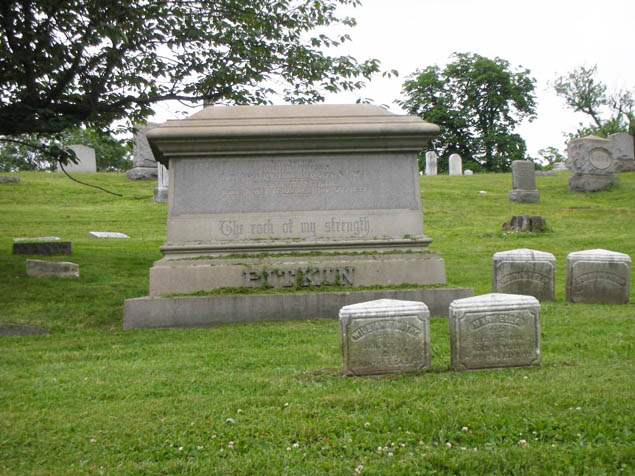 |
John R. Pitkin, the man who gave East New York its name and the first to try to develop it, is buried in a prominent location. | |
 |
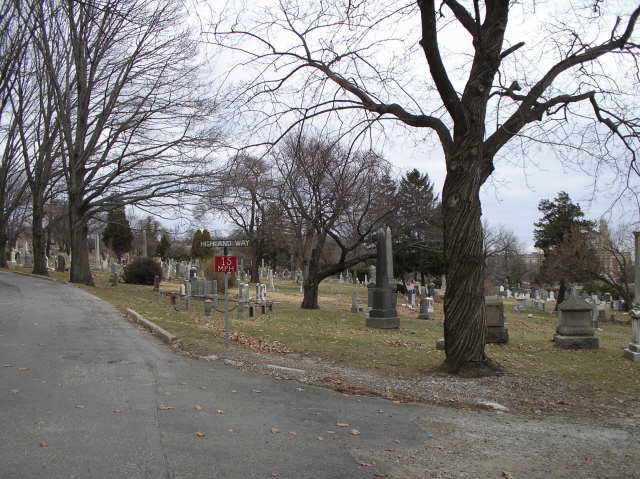 |
Cypress Cemetery, 2006 The following two shots are courtesy of Neil Sullivan. On the left is the office as it appeared in 2006 at the entrance, and on the right Highland Way, with FK Lane visible in the distance. The office has since been completely renovated into a two-story structure, we need to add an update shot. |
 |
Photo courtesy of Neil Sullivan, these crypts were built into the hillside. | |
 |
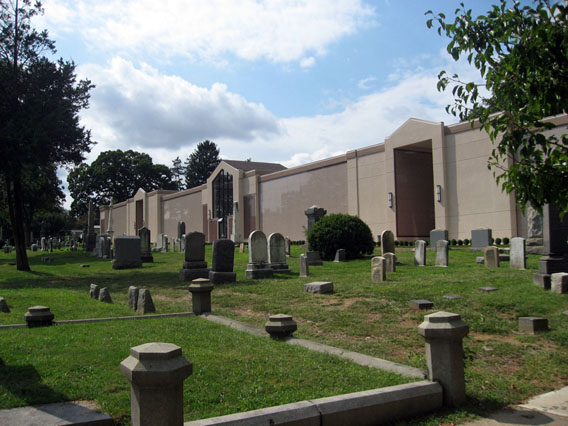 |
Melrose Memorial Gardens Peter Stango supplied a 2008 update, the Melrose Memorial Gardens were completed. |
| In 2014, a plaque was dedicated in Cyperss Hills Cemetery at the crypt of Dr. Thomas Holmes, a Williamburgh physician who was recognized as the father of embalming in America. He devised an embalming technique during the Civil War which enabled the transport of Northern soldiers killed in action down south to be brought back home for burial. | ||
| The following articles related to the history of Cypress Cemetery can be found at the Brooklyn Eagle Online July 28, 1874- Early history of Cypress Cemetery June 7, 1891- Announcement of plans for new entrance and office building June 13, 1894- Demolition of Tower December 4, 1896- Building of new office |
||